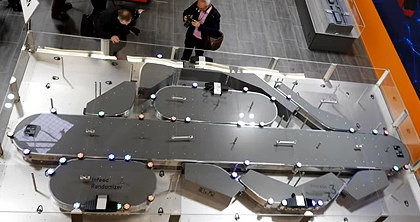- Home » News » Technology News
Production transport system is ‘first’ to handle batches of one

At the recent SPS IPC Drives show in Germany, ABB’s recently-acquired subsidiary, B&R Automation, unveiled an “intelligent” transport system designed to bring new levels of flexibility to the movement of production-line components at high speeds, using independently controlled shuttle carriages.
The linear-motor-driven ACOPOStrak system is claimed to extend the economies of mass production down to batches of one for the first time. Manufacturers will be able to produce many different variants of a product on one machine, without needing to interrupt production.
“It will change the way that flexible machines are built,” predicts B&R’s manager of mechatronic technology, Robert Kickinger. He describes the system as “motion control technology for the age of digitalisation”.
The track’s hot-swappable shuttles can be replaced within seconds without needing any tools. They are held in place on the track by permanent magnets. All the operator has to do is to place the wheels of the new shuttle onto the track’s guides. The system is capable of 5g acceleration and can reach top speeds of more than 4m/s with a minimum spacing between the shuttles of just 50mm.
The tracks can be more than 100m long and can each carry more than 250 shuttles, controlled by a single PC.
A key element of the system is the use of wear- and maintenance-free electromagnetic diverters that can divide and merge product flows at full production speed. Collision avoidance is built in.
Among the diverters’ many advantages is the ability to include “pit lanes” in the track layout, where new component-carrying shuttles can be mounted onto the track – by humans or by robots – and then sent onto the production line via a diverter.
Similarly, any shuttles that are no longer needed can simply be rerouted to the pit lane. All of this takes place at full production speed. “It becomes possible to perform product changeovers with zero downtime,” Kickinger explains.
Another use of the diverters is to split products among several parallel stations for processes that take longer to complete. Product flows can be divided, pass through multiple processing stations, and then converge further down the line. Production speeds are no longer restricted by the station with the slowest processing time, boosting productivity without increasing the machine footprint.
Mass-produced items, such as bottled beverages, can be grouped on-the-fly into custom six-packs – in any combination of flavours – without changing the hardware. The diverter can also eject defective products as soon as they are identified, rather than them having to continue to the end of the line.

“The diverter is – quite literally – a pivotal component of the system," explains Kickinger. “It is 100% electromagnetic and therefore entirely free of wear.” Like a road junction, the diverter allows product flows to diverge and converge. “The diverter allows the shuttles to switch tracks at full speed, with no compromise in productivity,” Kickinger adds.
The core of the track system is a long-stroke linear motor assembled from a choice of track segments, including straight sections and curves in 45 and 22.5 degree angles.
This variety will allow designers to create open and closed layouts in almost any configuration. They simply describe the rules that define the product flow on the track, rather than having to program axes and shuttles individually. Layouts can be simulated in 3D on a PC to test configurations and application code before they are deployed as real hardware. This reduces development times and will help to get machines to market faster, according to B&R.
The track is protected by a stainless-steel housing that meets hygiene requirements in food and pharmaceutical applications.
The ACOPOStrak system has been developed in-house by B&R – unlike its earlier SuperTrak system, introduced two years ago, which was designed by the Canadian developer, ATS Automation. B&R will continue to offer SuperTrak, which is limited to oval configurations, but has a larger load-carrying capacity than the new system.
“In developing the intelligent ACOPOStrak transport system,” Robert Kickinger concludes, “we have set the stage for revolutionary new machine concepts.”






